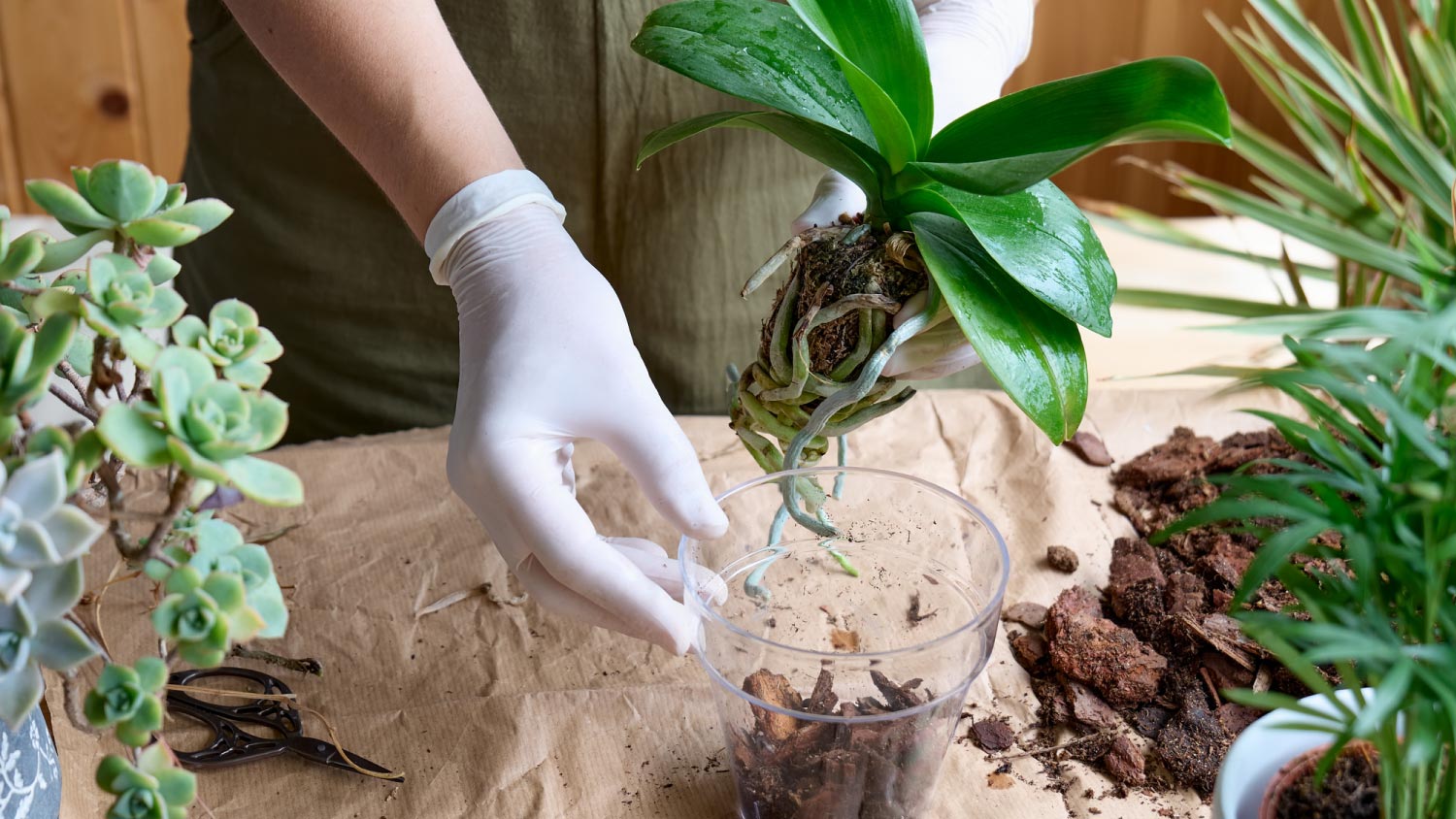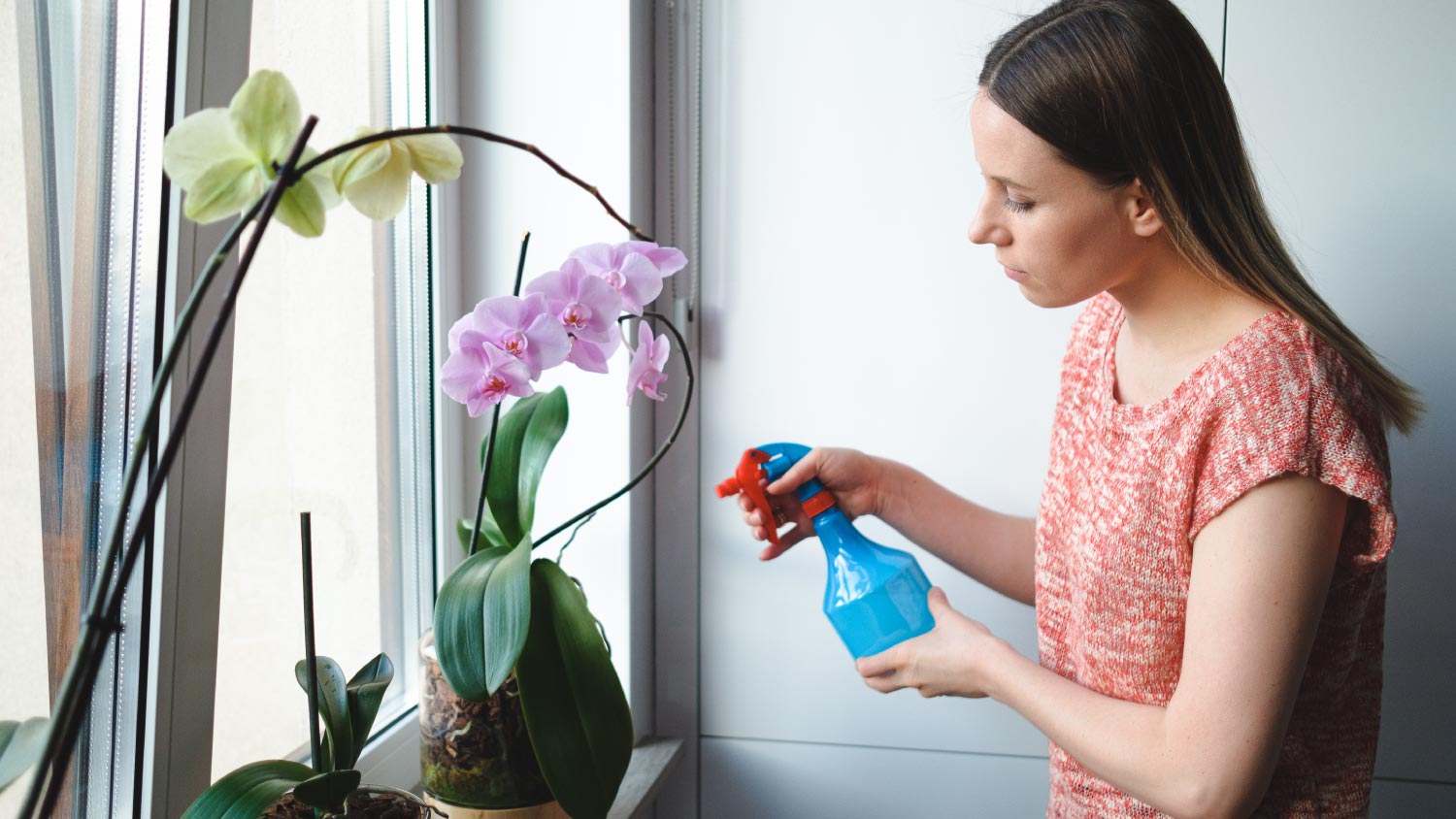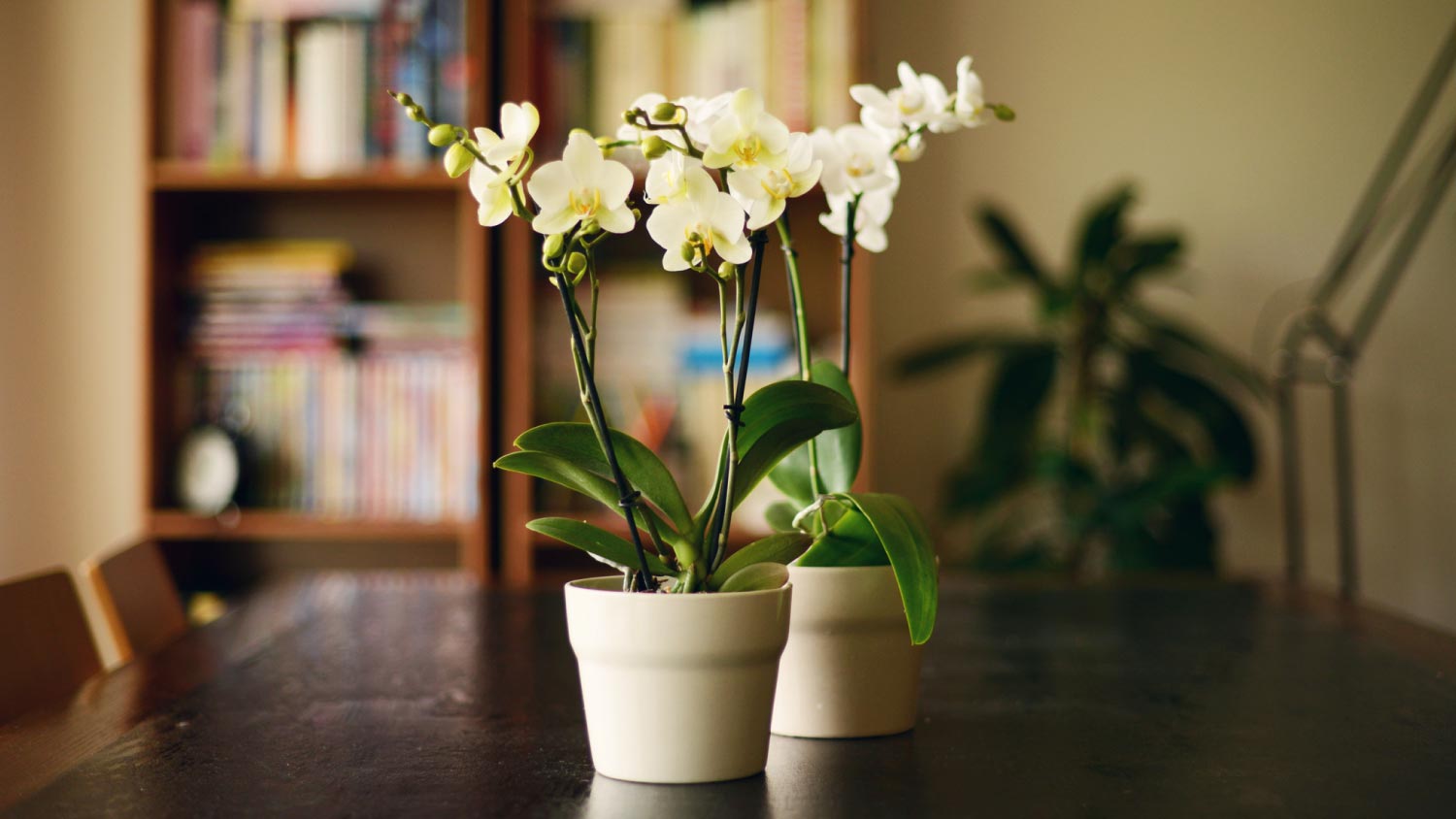How to Care for Orchids for Beautiful Blooms and a Long Life
Care for orchids like a pro


Somewhere along the line, orchids got the reputation that they’re not for beginners. Orchids, however, are not naturally difficult to care for—they just have different needs than, say, caring for your other standard indoor plants.
Once you take the time to understand how orchids grow and how to keep them happy—as well as its common blooming schedule—you could have a stunning new member of your plant family that lasts for years and years.
What Are Orchids?
Orchids are a family name that covers hundreds of orchid types (aka genera) and thousands of orchid species. Basically, using the word orchid is about the same as simply saying succulent. Some species of orchids attach to trees—known as epiphytes—while others prefer either rocks, water, or traditional soil.
In other words, it's important to look up how to care for orchids based on their unique genus and species. Perhaps this is where they get their distinction for being fussy—it's not that orchids require a lot of care, but more that each one prefers a different daily routine.
Orchids grow naturally all over the world in tropical areas with mid-to-high humidity and indirect sunlight that pokes through the canopy of the trees. They grow best in hardiness zones 6 to 9.
When you purchase an orchid at a store, you'll likely find a cross-bred species ideal for indoor orchid care that produces stunning flowers once or several times a year.
How to Care for Orchids
Becoming an orchid expert just comes down to understanding why orchids need what they need. And while they're not exactly the kind of plant you can forget about, you also don't need to fuss with it every day.
Let's walk through all the ways to care for your orchid and understand its growth and blooming cycle, whether you plan to have it indoors or out.
1. Understand Orchid Soil

After confirming the type of orchid you own, choose the best plant potting soil based on its natural habitat. For example, most homegrown orchids thrive in a store-bought, well-draining orchid potting mix.
The loamy mixes will feature a collection of bark and other natural materials that hold moisture but also filter out excess water.
Orchid potting mix often includes:
Fir bark
Peat moss
Lava rock
Perlite
Sponge rock
Charcoal
You can also choose a soil mixture made up entirely of fir bark found at your garden center. The mixture is best for epiphyte orchids that only need bark to lay their roots.
2. Opt for All-Day Indirect Light
Arranging for the right level of natural sunlight will help your orchids feel at home. Too much sunlight can dry out and shock your orchid, while too little will cause them to fade.
Whenever possible, choose a window that gets indirect but consistent light throughout the day. You can even place a curtain in between the plant and the sunlight, especially if the light filters in through the open pattern of the curtain.
If you live in a warm, humid area and plan to set your orchids on the patio or in your backyard, find a spot that doesn't have hard direct sunlight for too long, if at all. Too much or too little light can keep your plants from blooming to their full potential and cause foliage to droop.
When planting orchids in a garden, opt for a spot that gets midday shade to protect them from the hottest part of the day.
3. Find the Ideal Pot

When you receive an orchid as a gift, there's a chance it will also come in a beautifully decorated pot to match the ornate style of the orchid itself. While these pots may be pretty, they're not always the best for indoor orchid care.
While you don't need to check all of these boxes, the right pot for orchids ideally:
Filters out excess water via holes at the bottom of the pot
Holds enough moisture to reach the roots
Keeps the roots steady for strong growth
Allows the roots to grow out the top if necessary
Allows sunlight to filter to the roots
Does not harbor bacteria
Moisture balance is the most important factor on the list. Plastic containers—often the ones the orchid comes in from the garden store—typically feature enough holes for the water to drain while still holding in warmth and humidity.
Terracotta pots, on the other hand, have the upper hand when it comes to absorbing moisture to slowly feed the roots. Its weight can also keep the pot standing as it grows.
If you prefer to have your orchids outdoors, you can use a raised garden bed, plant them under trees, or have them in pots around your home. Talk to a landscape designer in your area about integrating orchids beautifully throughout your yard.
4. Re-Pot and Change the Soil
Young orchids will likely live in small pots that support their root systems. But as they grow, it's important to switch the plant to a larger pot when the time is right. While you get signs that the plant needs a larger home when the flowers of foliage droop, you're likely to see issues when the visible roots go brown or your soil no longer retains moisture.
Overall, you will likely need to switch your orchid to a larger pot and change the soil every one to two years.
5. Create a Watering Plan

One of the perks of choosing a clear container is a clear view of the orchid's roots. Bark and orchid potting mix will lighten when it's totally dry and darken when still wet. The trick to watering orchids is to avoid root rot with too much moisture or adding too little water for it to thrive.
Watering your orchid thoroughly once a week is often best. If the potting soil retains moisture longer, you may need to wait between 10 days and two weeks to water it again.
Avoid spritzing the orchid every day with a water bottle or trying any funny tricks like placing ice cubes at the roots. Once a week, soak the plastic or terracotta planter with a watering can or under a light faucet when the soil is dry to the touch.
Water outdoor orchids more in the summer months to keep them thriving in hot temperatures.
6. Create Tropical Conditions
More so than many other houseplants, it's important to measure the humidity level of your home when caring for an orchid. Most homes in humid areas hang between 40% and 50%, but can drop significantly in the winter or if you have consistent air conditioners on blast.
Orchids do best in humidity levels over 50%. To pull this off, add a humidifier to the room or group your orchid with other plants. If you're feeling dedicated to your orchid care, you can even build a DIY greenhouse. However, large projects are not necessary for proper indoor orchid care; you'll just want to watch for low humidity.
7. Fertilize on a Schedule

The American Orchid Society (AOS) recommends spraying a heavily diluted fertilizer—at a quarter strength—on your orchids about once a week.
It's best to purchase fertilizer specifically made for orchids, though these are typically defined by having a balance of nitrogen, phosphorus, and potassium (NPK) and trace elements.
However, it's also best to choose a fertilizer with as little urea as possible. Urea is one of the primary forms of nitrogen often used in fertilizer, but also one that can be difficult for orchid roots to absorb. Many orchid fertilizer bottles will advertise being urea-free.
Every one to two weeks—often a day after watering—spritz your orchid with the diluted mixture of fertilizer. The orchid will appreciate the slow and steady stream of nutrients without getting inundated all at once.
8. Stake Your Plant
Check the species of your orchid when you purchase it to determine if it will benefit from staking. Stakes can help new and existing spikes—stems that will produce flowers—to grow tall and strong without tipping over.
While it is not often necessary to stake orchids, the process can make them look better and help you avoid having to prop up the pot as it gets top-heavy.
Most spikes that reach at least 4 inches require staking, though again, this depends on the species. Keep an eye on the new green shoots coming from the root ball of the plant. Choose either a reusable plastic stake or a curved stake to encourage more natural growth.
Your orchid stake kit should include small clips or ties that connect the plant to the stake without squeezing the stem.
Orchid Care Tips

The early stages of learning how to care for orchids will have a bit of trial and error, and that's okay. Finding the right balance of soil, light, water, and fertilizer can take time.
Additionally, there are a few small tips you can incorporate into daily orchid care to encourage them to flourish:
Pay attention to room temperature: Choose a room that remains between 60–80 degrees Fahrenheit for indoor orchids.
Consider keeping outdoor orchids in pots: A garden full of orchids would be beautiful but keeping them in pots allows you to bring them inside if temperatures dip too low or go too high.
Bring outdoor orchids inside in the winter: Generally, orchids can withstand temperatures as low as 40 degrees Fahrenheit as long as there’s no frost. Bring them inside if frost forms on their leaves.
Hit ‘em with humidity: Bathrooms and kitchens are popular spots for orchids due to their high humidity.
Prune roots with caution: Avoid trimming overgrown roots unless they are dried and dead. Otherwise, roots growing over your pot are a sign it's time to replant in a larger container.
Look at the leaves: Leaves will darken significantly in color if they are not getting enough sunlight but fade if sitting in too much light.
Research dormancy periods: Check your specific species of orchid to learn about its dormancy period in the winter. If your orchid does naturally go dormant, you may need to cut back on watering and fertilization.
Check for pests: While pests are uncommon for indoor orchid care, you can end up with thrips, mealy bugs, or spider mites. Remove the pests by hand or apply a horticulture soap to discourage infestations for both indoor and outdoor orchids.
DIY Orchid Care vs. Hiring a Gardener
Perhaps you're feeling a bit nervous about keeping your new orchid friend thriving. Hire a local gardener who can also water and care for your orchids as part of their rounds. The cost of gardeners widely varies based on the amount of work you need on a regular basis, but expect it to come out to around $50 to $150 per hour.
While this service may make sense if you have a whole room full of orchids and other plants that need care or if you have a bountiful garden outdoors, DIY orchid care can save you a lot of money. Speak with the specialists at your local nursery to confirm the species of your orchid and make a plan that keeps your orchids thriving year-round.
Additional Questions
How can beginners care for orchids indoors?
Beginners can learn how to care for orchids even if they're new to the houseplant scene. Start by creating the right setting for your orchid. Choose a spot that gets all-day, indirect sunlight and check that your home's humidity is at least 50%.
Next, create a watering and fertilizer schedule every one to two weeks and keep an eye on root health. Outside of these basic tips, orchids require minimal fuss from day to day.
Can you grow orchids outdoors?
If you live in a place with mild temperatures, you can grow orchids outdoors. Sixty degrees to 80 degrees Fahrenheit is ideal for outdoor orchids, but these flowers can withstand occasional heat waves above 100 degrees Fahrenheit and cold spells as low as 30 degrees Fahrenheit.
How long do orchids live?
Orchids can grow indoors for up to around 15 years when cared for properly. Don't be fooled by the myth that orchids need to be tossed as soon as their petals fall off for the season. Like most plants, orchids only bloom during their prime growth season and remain green and gorgeous during the rest of the year.
How many times will an orchid bloom?
Orchids bloom between one and three times a year on average, but this depends on the species of orchid you have. There are other factors, such as soil health, sunlight, and fertilizer, that can also encourage multiple blooms in some species.





- Landscapers
- Tree Surgeons
- Gardening Services
- Landscape Architects
- Sod Installation
- Tennis Court Contractors
- Landscape Design
- Retaining Wall Companies
- Grading Companies
- Landscape Rock & Sand Delivery
- Mulch Delivery Services
- Pond Companies
- Artificial Grass Companies
- Shrub Removal & Trimming
- Backyard Design Companies
- Commercial Landscaping
- Koi Pond Services
- Backyard Landscapers
- Trampoline Assembly
- Hedge Trimming
- Pond Services
- Garden Design
- Outdoor Plant Watering
- Putting Greens
- French Drains
- Turf Installation
- Sod Removal Services
- Lawn Repair Services
- Brush Chipping Services
- Hardscape Contractor
- Landscape Rock Removal
- How to Spruce Up Your Existing Garden by Adding New Plants
- Take Up Home Gardening This Year With Our Ultimate Introduction Guide
- Need a Vacation? How to Keep Your Plants Alive When You’re Out of Town
- 47 Landscaping Ideas to Consider for Your Home
- Go Green: The Best Plants for Every Room in Your Home
- 13 Summer Landscape Tips That’ll Keep Your Grass Green and Plants Thriving
- How Often Should You Water New Landscaping Plants?
- How to Care for a Money Tree, a Low-Maintenance Houseplant You’ll Love
- Plant Like a Pro: 9 Gardening Influencers Share Their Secrets to Growing Thriving Plants
- The Truth About 12 Popular Garden Myths, From Plants to Soil










